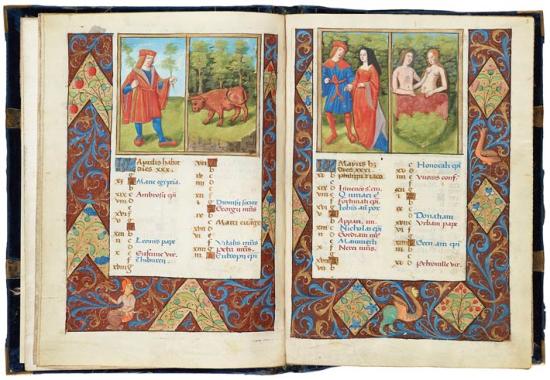
Psalter, in Latin and French
Illuminated by the Master of Philippe of Guelders and the Master of Jacques de Besançon
Bequest of Herbert H. Lehman, 1968
The young man carrying branches during the month of April wears the new sayon, the man's outer coat with a fitted waist and a many-gored skirt. Its large, slit sleeves are typical of the 1490s. On his head is the new carmignolle, the man's hat with a low crown and a divided, upturned brim, and on his feet are the new pantoffles, round-toed slippers. The man courting in May is similarly dressed, although his sayon has a wide collar instead of lapels. His girlfriend's gown features the period's square neck and small bombard sleeves. Her headgear is the coif plus frontlet.
Twilight of the Middle Ages
This was a period of transition in northern Europe—the Middle Ages were not yet over, and the Renaissance had not yet begun. Both King Charles VIII and Louis XII invaded Italy, and these military campaigns exposed France to Italian art, culture, and fashion. At the same time, the Late Gothic style still dominated the arts—and clothing—of northern Europe. Fashions of this period reflect these conflicts.
In the 1480s, the look for men changed abruptly. Padded shoulders and the V-shaped silhouette disappeared. Long loose open gowns came into style and, by the 1490s, these gowns became especially voluminous and bulky. Round-toed shoes replaced the pointy pouleines. New, however, and probably reflecting Italian influence, were the man's outer coat called a sayon, the man's hat called a carmignolle, and doublets with slit sleeves through which the linen of the shirt protruded.
Women's gowns of this period also became fuller, and bombard sleeves were revived. The neck got square. The turret disappeared, while its frontlet remained, now attached to a new small-crowned coif.
